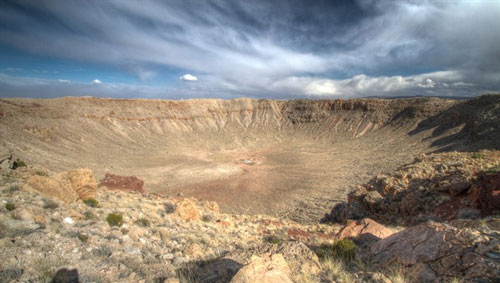| Apr 02, 2014 |
The tell-tale radiation from metallic asteroids
|
|
(Nanowerk News) In the process of evaluating thousands of datasets from the NASA Wide-field Infrared Survey Explorer (WISE) space telescope, planetary researchers at the German Aerospace Center (Deutsches Zentrum für Luft- und Raumfahrt; DLR) have been tracking metallic asteroids. These 'heavyweights' remain surprisingly cool, and seem to give off less thermal radiation than rocky asteroids when observed using an infrared telescope. "For me, this was a big surprise," says Alan Harris. "Our results suggest a higher number of metallic objects in the Solar System than previously suspected." This detection of metal-rich asteroids is important for various reasons – they are particularly dangerous if they impact Earth and are also potential sources of raw materials for industry in the future. The research results have been published in the current issue of Astrophysical Journal Letters.
|
 |
| Impact crater of a metal-rich asteroid – Barringer Crater in the USA.
|
|
Metal conducts heat better than rock. Alan Harris and Line Drube from the DLR Institute of Planetary Research used the principle of thermal conductivity to their advantage. Solar energy penetrates deep into the surface of metal-rich asteroids; therefore, the surface of these asteroids appears cooler in infrared observations. This can be demonstrated by comparing radar reflection and infrared radiation measurements of known metallic asteroids. So far, only about 40 asteroids have been identified as metal rich, but with the new infrared method developed by DLR scientists, that number will rise considerably. "Many asteroids in the WISE catalogue show signs of having a high metal content," explains Harris.
|
|
Threat to Earth
|
|
The asteroid explorer heads the international project NEOShield, in which, among other things, the characteristics of asteroids and the prevention of asteroid impacts on Earth are being investigated. The scientists have been examining the properties of Near-Earth Objects (NEOS), which could cause great destruction upon impact, since January 2012. "Metal-rich asteroids have a higher density and greater mass – and would be particularly dangerous if they reached Earth."
|
|
The 20-metre-diameter asteroid that broke up with a force equivalent to 500 kilotons of TNT, 20 to 30 kilometres above Russia, near the city of Chelyabinsk in February 2013, was a rocky object. A metallic asteroid of the same size would probably have remained intact at a much lower altitude during its flight through the atmosphere; the damage would have been considerably worse. The European Union-funded research within the NEOShield project helps asteroid researchers to assess such risks. “It is important to determine the composition of potentially dangerous asteroids as soon as possible," adds Harris. Only once the structure of an asteroid is known, can it, for example, be effectively diverted from its trajectory towards Earth.
|
|
Source of valuable raw materials
|
|
Cataloguing metal-rich asteroids could bring an additional benefit in the future – a supply of valuable raw materials for high technology industry, such as osmium, iridium, platinum and palladium. "This will affect, at the earliest, the next or following generations, but is now no longer completely unrealistic," suggests Harris. "Private US companies are seriously working on the opportunity to use asteroids as sources of raw materials, and NASA plans to lasso a large asteroid – about six metres in diameter – and bring it into orbit around the Moon, where it will be studied." One of the current problems is to find suitable objects among the asteroids. Harris and Drube's method of infrared observation provides a new way to select metal-rich candidates among near-Earth objects.
|
|
Ultimately, the study of metal-rich asteroids is a look back at planet formation processes. Most asteroids in the Solar System are the remnants of collisions that took place 4.6 billion years ago. Not enough is known about their general characteristics. "This is why, within the NEOShield project, we are currently conducting research in collaboration with 12 partners from academia and industry, and pooling our knowledge," says the asteroid researcher. In addition to the method for identifying metal-rich asteroids, the first results of computer modelling and measurement data for impact scenarios involving an asteroid are now available.
|

